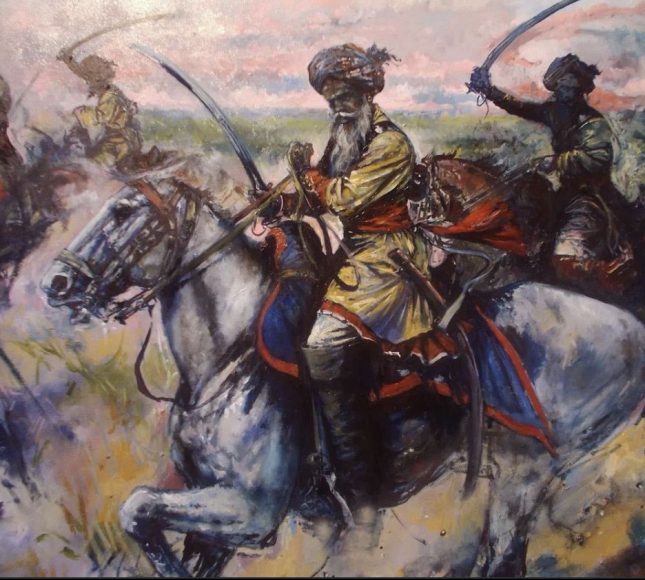CHATTHIAN DI VAR is a Punjabi ballad describing the battle between Mahan Singh, father of Maharaja Ranjit Singh, and Ghulam Muhammad Chattha, a Muslim chieftain of the Chattha clan of the Jatts. The poet is some Pir Muhammad, whose name appears in some verses of the poem. The Var was first published in Persian script by Qazi Fazal Haq, a teacher at Government College, Lahore. According to his statement, Pir Muhammad, the poet, was a resident of Gujrat district, and he composed this ballad in the early years of the British occupation of the Punjab.
No evidence is available in the text to support this statement. Nevertheless, the details of the events provided, and the casual way in which the poet has introduced different personalities as if everybody knew about them, indicate that he was an eyewitness to the happenings he has described. The events of the strife are spread over a period of a few years but no dates are given. Ghulam Muhammad became the chief of the Chatthas, after the death of his father, Pir Muhammad (not to be confused with the author of the poem), probably in 1785.
His adversary, Mahan Singh, died in 1792. As such the events narrated in the Var took place between 1785 and 1792. The Sikh sardars had occupied large portions of the Punjab by 1780, but some Muslim chiefs, who had created independent states for themselves in the wake of the downfall of Mughal authority, were holding out in certain areas. The Chatthas had their stronghold in the Wazirabad and Hafizabad parganahs where they were masters of 78 villages. They formed their own state under their leader, Nur Muhammad, grandfather of Ghulam Muhammad, and had sufficiently strengthened their position by the time the latter became the chief.
They had common boundary with Sardar Mahan Singh, and were always a source of trouble to the Sikh chieftain. Quite frequently they raided his territory and looted and plundered the villages. Mahan Singh was forced to retaliate. The Chatthas offered stubborn resistance to him from the fort of Manchar, which they were forced to evacuate after a long siege and considerable loss of life. It is a lengthy Var, with 91 pa up`s (stanzas) available and published. But it remains incomplete, and nobody knows how many stanzas the poem originally contained. After the 91st stanza, one verse from 92nd stanza has been given in the text. The first verse is in praise of the Creator.
Thereafter two full stanzas describe events from the lives of mythological and historical figures prophets, kings, great men ” from Semitic traditions. The poet comes to the subject in the fourth stanza. His description of events is sketchy though he does not lack poetic fancy and imagination. He is at his best when depicting a battle scene. Unlike most other Muslim poets he has no prejudice against words from Hindu or Sikh sources, nor is he excessively given to pedantic vocabulary of Perso Arabic origin. He belonged to Gujrat district and used the dialect of that region, which is a mixture of central Punjabi and Lahndi.
“CHATTHIAN DI VAR: A Punjabi Ballad of Epic Battles” is an evocative literary work that encapsulates both the martial spirit and rich oral tradition of Punjab during a time of significant upheaval. The ballad vividly recounts the conflict between Sardar Mahan Singh—the father of Maharaja Ranjit Singh—and Ghulam Muhammad Chattha, a formidable Muslim chieftain of the Chattha clan of the Jatts. This narrative is not merely a chronicle of physical confrontations but also a poetic document that mirrors the shifting power dynamics in Punjab during the late 18th century.
Historical and Cultural Context
The events narrated in the ballad are believed to span from approximately 1785 to 1792. During this turbulent period, while Sikh sardars had already expanded their dominion over much of Punjab, certain local Muslim chiefs still maintained pockets of independent rule. The Chatthas, with their stronghold encompassing regions like Wazirabad and Hafizabad, frequently raided neighboring territories. Their ceaseless provocations compelled Mahan Singh to respond decisively, resulting in long sieges—most notably at the fort of Manchar—that are recounted with considerable detail and emotional gravity in the Var.
The Poetic Craftsmanship and Authorship
Attributed to a poet by the name of Pir Muhammad (whose identity is distinct from another figure of a similar name mentioned within the text), the ballad was composed in Punjabi, though initially published in Persian script by Qazi Fazal Haq, a teacher at Government College, Lahore. The casual, almost eyewitness tone in which various personalities and events are introduced suggests that the poet may have experienced or closely witnessed these epic occurrences. The Var is a lengthy composition, extant in 91 stanzas—with a fragment from a 92nd stanza also in circulation—yet its original extent remains uncertain. Each stanza weaves together not only the narrative of conflict but also reflections on honor, valor, and the inevitable cost of warfare.
Epic Battles and Enduring Legacy
“CHATTHIAN DI VAR” is much more than a historical account—it is a vivid ballad that simultaneously serves as an artifact of cultural memory. By focusing on the dramatic battles and strategic maneuvers between rival powers, the poem encapsulates a moment when the valor of Sikh chieftains was both tested and triumphantly vindicated. The ballad’s enduring appeal lies in its ability to blend dynamic battle scenes with lyrical expressions of duty and sacrifice, offering modern readers a window into the collective consciousness of a people in the throes of transformation.
This Punjabi ballad stands as a testament to how literature can document historical realities while elevating them to the realm of epic narrative. It preserves the memory of a crucial era when martial prowess, strategic acumen, and cultural identity were deeply interwoven—a theme that continues to resonate with those exploring the rich tapestry of Punjabi and Sikh heritage.



